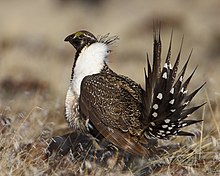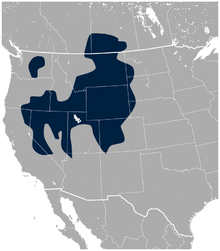Greater sage-grouse
The greater sage-grouse (Centrocercus urophasianus) is the largest grouse in North America. It lives in the western half of the United States and the Alberta and Saskatchewan provinces.[3] They are larger than a pheasant but smaller than a wild turkey.
| Greater sage-grouse | |
|---|---|

| |
| Male in USA | |
| Scientific classification | |
| Domain: | Eukaryota |
| Kingdom: | Animalia |
| Phylum: | Chordata |
| Class: | Aves |
| Order: | Galliformes |
| Family: | Phasianidae |
| Genus: | Centrocercus |
| Species: | C. urophasianus
|
| Binomial name | |
| Centrocercus urophasianus (Bonaparte, 1827)
| |
| Subspecies | |
| |

| |
| Sage grouse range[2] | |
They belong to the Phasianidae family. The Gunnison sage-grouse (Centrocercus minimus) is the other species in the genus.[4]
Populations
changeAt one time they numbered in the millions. Because of loss of the loss of sagebrush habitat there are now between 200,000 and 500,000 birds in the western US.[5] They are now being considered for listing under the Endangered Species Act (ESA).[5] In Canada It is estimated their habitat range has been reduced by 90%.[6] They are completely gone from British Columbia.[6] It is estimated the population in Canada was reduced by 88% between 1988 and 2006.[6]
Courtship
changeIn the spring, during their breeding season, male sage-grouse gather to do their courtship displays.[4] They do this on areas called "leks". As the males dance they make a popping sound.[7] This is done by inflating and deflating their two yellow throat sacs. They display their pointed tail feathers while they strut.[7] As many as a dozen males may dance at the same time. Sometimes two males will fight with their wings. The hens will watch for several days before picking out a mate.[7] They make their nests in the sagebrush.[4] The males do not help with nesting or with raising chicks.
References
change- ↑ BirdLife International (2012). "Centrocercus urophasianus". IUCN Red List of Threatened Species. Version 2015.3. International Union for Conservation of Nature. Retrieved 24 September 2015.
- ↑ BirdLife International and NatureServe (2014) Bird Species Distribution Maps of the World. 2012. Centrocercus urophasianus. In: IUCN 2014. The IUCN Red List of Threatened Species. Version 2014.3. http://www.iucnredlist.org Archived 2014-06-27 at the Wayback Machine. Downloaded on 15 March 2015.
- ↑ "Sage Grouse Centrocercus urophasianus". Birdlife International. Archived from the original on 23 October 2015. Retrieved 24 August 2015.
- ↑ 4.0 4.1 4.2 "Beginner's Guide to Greater Sage-Grouse" (PDF). United States Fish and Wildlife Service. Archived from the original (PDF) on 17 June 2015. Retrieved 24 August 2015.
- ↑ 5.0 5.1 "Sage-Grouse and Sagebrush Conservation". U.S. Department of the Interior, Bureau of Land Management. Archived from the original on 5 September 2015. Retrieved 24 August 2015.
- ↑ 6.0 6.1 6.2 "Greater Sage-Grouse urophasianus subspecies". Species at Risk Public Registry, Government of Canada. Archived from the original on 24 August 2017. Retrieved 24 August 2015.
- ↑ 7.0 7.1 7.2 "Dawn on the Spring Prairie". Sage Grouse Initiative. Retrieved 24 August 2015.
Other websites
change
